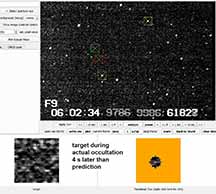

This is a good event worth going for, passing through Santa Cruz Mtns. The event is on the bright side at 12.0, and lasts 1.2s so should provide an accurate shape profile and astrometry point, even perhaps a moonlet, if it's there. We've spread Team Santa Cruz across the profile; I plan to be at the BD airport, Kirk at "the Berm", and Karl at home on the north side. All inside the path.
Alt=24, Az=196 Just above the spout of the Sagittarius teapot, to the right of the top of the lid.
 |
 |
I observed from the Bonny Doon airport on Sunlit lane, at the extension of the NE runway lights to the west side of Sunlit lane. I integrated at 4x. I had good conditions, except there were two gusts of wind that disturbed the telescope and caused added noise to all 3 stars (2 ref stars and 1 target star) at those two moments, which only lasted less than a second for each gust, and are clearly seen in the light curves before the predicted time and before the actual event seen. These two wind gust moments did not correspond to a rather high significance 1.0 second drop to ~zero brightness. It was 4 seconds after the predicted occultation time. It appears to be real.
While OW desktop gave a nominal center time of 6:02:28 for the long/lat of Cabrillo College, For Sunlit lane, the predicted center time was 3 seconds later at 6:02:31 UT. I've made that change on the headline for this webpage.
Kirk did not have an apparent event at his location. However, a short dip is at the right position corresponding to my event, but not deep enough and not statistically significant says PyOTE. Kirk was 1/3 radius of the asteroid south of my track. He could have been at the southern limit and I south of but not at, the centerline. That could explain our results. The 4 sec offset in time is surprising, but given the misses at "high probability" events from small asteroids in the past, not all that unlikely.
I ran two analyses.
Thist gave a high confidence solution of an event 4s later than predicted, with the following timings.
magDrop report: percentDrop: 87.5 magDrop: 2.254 +/- 0.585 (0.95 ci)
DNR: 3.31
D time: [06:02:34.5447]
D: 0.6800 containment intervals: {+/- 0.0188} seconds
D: 0.9500 containment intervals: {+/- 0.0520} seconds
D: 0.9973 containment intervals: {+/- 0.1024} seconds
R time: [06:02:35.5817]
R: 0.6800 containment intervals: {+/- 0.0188} seconds
R: 0.9500 containment intervals: {+/- 0.0520} seconds
R: 0.9973 containment intervals: {+/- 0.1024} seconds
Duration (R - D): 1.0371 seconds
Duration: 0.6800 containment intervals: {+/- 0.0286} seconds
Duration: 0.9500 containment intervals: {+/- 0.0660} seconds
Duration: 0.9973 containment intervals: {+/- 0.1256} seconds
|
A second smoothing, longer (24 points) still gives a solid event 4 seconds after the predicted event time, and 8s after the 2nd wind gust |
False Positive test passed easily |
Given the noise created by the wind gust, I felt it worth doing a second analysis using the "dynamic aperture" method, which was designed especially for just this situation of a non-circular blurred star light distribution. That also produced a significant event in PyOTE
magDrop report: percentDrop: 84.2 magDrop: 2.007 +/- 0.605 (0.95 ci)
DNR: 2.27
D time: [06:02:34.5786]
D: 0.6800 containment intervals: {+/- 0.0285} seconds
D: 0.9500 containment intervals: {+/- 0.0881} seconds
D: 0.9973 containment intervals: {+/- 0.2162} seconds
R time: [06:02:35.5882]
R: 0.6800 containment intervals: {+/- 0.0285} seconds
R: 0.9500 containment intervals: {+/- 0.0881} seconds
R: 0.9973 containment intervals: {+/- 0.2162} seconds
Duration (R - D): 1.0096 seconds
Duration: 0.6800 containment intervals: {+/- 0.0438} seconds
Duration: 0.9500 containment intervals: {+/- 0.1131} seconds
Duration: 0.9973 containment intervals: {+/- 0.2495} seconds
 |
 |
Kirk Bender and I have recorded events in which we had at or very close to 100.0% nominal probabilities of an event, yet still had misses. These were all small asteroids, but still nominally high rank events. I believe the accuracy of the astrometric orbit solutions for these very small asteroids is over-stated. It also translates to this event, which appears to be 4s too late, so the error was mostly in the along-track dimension, not cross-track.
I don't see a hint of an event for 2001 RN131, 2x at BD Eco Reserve, last Monday night Aug 12 evening. I tried both TME (attached) and a 12 stack of static apertures, both nothing. Maybe I should have done 4x but still a max duration of 1.32 sec should have shown something at my 2x setting I'd think.
 |
 |
 |
 |
Karl, then, should have had an event at his site at home, but he did not observe.